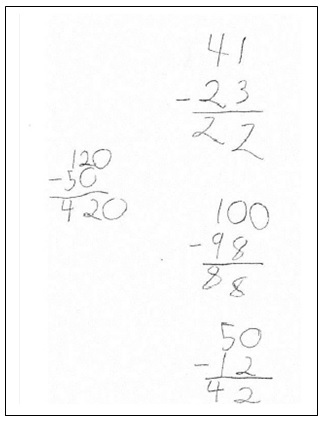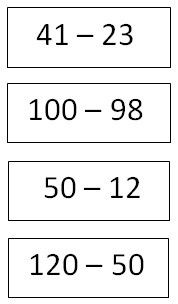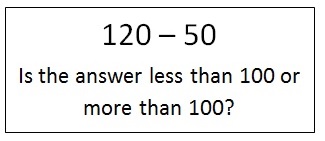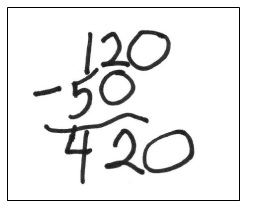I was inspired to write this post after I read a post on Joe Schwartz’s blog: When Bad Things Happen to Good Algorithms. I started to write a response to the post on Joe’s blog site, but I got long winded. So here it is.
In his post, Joe includes examples of student work from third and fourth grades that he collected over the past several weeks. The blog was especially timely for me as I was preparing to teach Ruth Cossey’s elementary math methods class at Mills College. As I looked through my collection of student work, a paper from a third grader, Nomar, reminded me of what Joe was talking about. I had interviewed Nomar, and his paper showed solutions, all incorrect, for four of the problems I had presented to him. [What do you notice about Nomar’s work?]

Two Things I Noticed from Nomar’s Work:
When I interview students, I present problems horizontally and ask students to figure out answers in their heads. (See my response below to Joe’s question below about presenting calculations verically vs horizontally.)

However, Nomar asked for pencil and paper to solve these four problems. When I reviewed his work, I noticed two things:
- In these problems, Nomar consistently subtracted the smaller digit from the larger. (He seemed to use a “do what you can” strategy; i.e., in the first problem instead of subtracting 1 – 3, he figured 3 – 1.)
- When writing 100 – 98 and 120 – 50 vertically, Nomar lined up the numbers on the left, not according to their place values. (This isn’t totally surprising when I think about how much we emphasize going from left to right in reading instruction.)
A Shift I’m Trying in Interviews
Before asking students for answers to problems like the ones I gave Nomar, I’m finding that it’s useful to pose a question that asks them to think about what’s reasonable, giving them a specific parameter rather than asking for an estimate. Here’s an example:

After the student responds, I always ask, “Why do you think that?” This gives me the opportunity to assess the student’s number sense. Without number sense, I don’t think teaching an algorithm is appropriate.
About Joe’s Noticing and Wondering
Below in italics is what Joe wrote at the end of his post related to the examples of student work he posted. My thoughts follow each of Joe’s comments.
- These students have underlying issues with place value.
This is a problem for Nomar, and a problem I encounter regularly.
- All these students have seen and used base-10 blocks. They’ve been taught to add, subtract, and multiply using partial sums, differences, and products. For some reason they default back to a traditional algorithm, even though many of them haven’t even encountered the traditional algorithm yet. So they must be picking it up somewhere. Maybe on the bus?
Maybe they pick up the traditional algorithm on the bus. Maybe from parents or older siblings. Or maybe the manipulation of base-10 blocks simply doesn’t translate for them to paper-and-pencil calculations. A confession: I no longer use base-10 blocks when trying to develop algorithmic understanding or proficiency. I think that base-10 blocks have value for helping reveal the underlying place-value structure of our number system, but using them to teach a regrouping strategy for subtraction, for example, too often has disappointing results.
- Are these examples of what I’ve heard called over-reliance on the traditional algorithm?
I think that algorithms, whether with base-10 blocks or paper and pencil, too often focus students on “doing something with the digits” instead of “making sense of quantities that the numbers represent.” I asked a class of sixth graders, How much is 50 percent of 36? and more than half reached for paper and pencil, rather than thinking first. Oy.
- All of the answers are wrong, but some egregiously so, like 1,000 – 500 = 1,500. Or 37 x 35 = 245.
It was the same with Nomar subtracting 120 – 50, arriving at the answer of 420, and never noticing that it’s ridiculous. If I had asked Nomar the estimation question I suggest above about whether the answer is less than 100 or more than 100, I might have learned more.
- Is there a difference in the way kids do these kinds of calculations when they are presented vertically vs. horizontally? Has anyone done any research on that?
I don’t know of any research. But in my experience, seeing problems vertically seems to trigger applying an algorithm. Seeing problems horizontally seems to have more of a potential of not triggering the algorithm. That said, it’s not enough to present problems horizontally and think that it will necessarily encourage kids to reason.
- These are not necessarily representative; many kids can add, subtract, and multiply multi-digit numbers just fine. But do we confuse some kids by attempting to teach them multiple ways to do these multi-digit calculations? Are some kids better off just learning one way? Or at least one way at a time? This is something I hear quite often from teachers. Are they right?
Here’s my thought: If I’m focusing on teaching an algorithmic procedure for students to learn, then it seems that one procedure is enough. If I’m focusing on helping students develop ways to reason, then multiple strategies are valuable.
- Graham Fletcher, in his addition and subtraction and multiplication progression videos, urges us not to rush students through conceptual stages of understanding. My guess is that what we’re seeing here is the result of such rushing. It’s also likely that there are students who are calculating correctly by following the traditional algorithm, but have little or no understanding of the underlying concept. Masked by correct answers, their misconceptions go undetected, and that is just as troubling as what we see above.
Over and over again, I’ve seen correct answers mask lack of understanding and incorrect answers mask understanding. I think it’s important to keep the emphasis of math instruction in all instances on thinking, reasoning, and making sense.
My Final Thought
While algorithms are valuable and important, I think it can be helpful to emphasize that the best use for paper and pencil is to keep track of thinking, not to robotically perform a procedure.
Stay tuned for how I addressed the algorithm issue when I taught Ruth’s class. I’ll post a blog about that in a few days.
And thanks, Joe, for your post.


This response is so thoughtful and valuable. Must remember to present expression horizontally; promote estimation and thinking BEFORE computation.
Very interested in why you no longer use PV materials while teaching subtraction with regrouping. What do you recommend instead?
The reason I don’t use the base-ten blocks for teaching subtraction with regrouping is that they didn’t seem to help. I had students spending lots of time modeling problems, but still too many were confused. I don’t have a silver-bullet answer, but one approach that I use to develop subtraction strategies is the open number line. I wrote about this in an earlier blog. After developing other strategies and focusing on number sense, presenting the algorithm and talking with students about why it works seems to work as well as using the blocks.
I agree with skipping base ten blocks. I actually start with a hundreds chart (if using a counting up strategy) and a 99 chart (if using a counting back strategy). I use their movement on the chart to start their thinking about using the open number line. The strategies mentioned above can be represented very easily on the open number line. I also help students see a way to abstractly record these strategies. The strategy is the same regardless of the tool.
Thanks, Marilyn and Joe! I’m a fourth-grade teacher. It is good to know that I’m not struggling alone. I get so frustrated when I see these sorts of mistakes show up in my students’ work especially when I know that they are, in some ways, above such mistakes. Like Joe, I feel like we’ve done the work necessary to build conceptual understanding and we’ve analyzed and practiced procedures for finding sums, differences, products, and quotients that tap into the students’ understanding of place value. Still, this struggle is real! If there is one thing I wish, it is that students would be more generous with the amount of think time they give themselves. I’m working so hard to encourage my students to slow down and visualize the problems. I know that taking the time to analyze what’s going on in a problem and thinking about what a reasonable answer will look like will benefit my students. Marilyn, I love the suggestion you make in your blog. Giving students specific parameters to consider will help to both focus their thinking and slow them down. I’m eager to see the impact that such parameters might have on my students’ success. Thanks for helping me to think about this challenge more deeply.
So many amazing bits between the two posts. I wish I could print this and put it on all of my teachers’ desks. I’ll just leave this one here: When I taught abroad, I was dumbfounded when told that in 2nd grade, not only should I not be teaching the “vertical algorithm” but that I shouldn’t even be presenting number sentences vertically at all. Having taught for a measly 3 years here in the states, I was frozen with panic. I had not been given any other strategies to teach “sums & differences” other than the algorithm. As someone who loves math, this was a frightening realization. Luckily they set me up with some incredible PD that changed who I was as a teacher. This goes along with, “So they must be picking it up somewhere. Maybe on the bus?” Until I was offered assistance in another country, I had no other tools to rely on. We are talking about changing the perspective of generations of well-meaning folks who simply were never taught another way. Can I also just shout-out to the internet for allowing us to have these amazing conversations!?
As always, Marilyn gives me a lot to think about and share with my pre-service teachers. After 33 years of teaching elementary school and ten years teaching college, it is still important to study student errors and interview them to find out how they are thinking about math problems. Joe, thanks for your post as well. I suggest all of my students read this blog for insights into teaching.
Oh my gosh ~ YES!!!! Thank you for these conversations and for promoting the development of true mathematical understanding! As a Title I math specialist, I see these problems daily, and I am constantly looking for ways to combat this “I can’t do math without my paper and pencil/algorithm” mentality. PLEASE keep the great ideas coming!!!
Thank you for your insightful reflection. I am a high school math teacher and my youngest child is in 4th grade. I am a proponent of teaching students a variety of strategies to solve problems, and I feel that it is important that students feel / discover / need that new strategy. Maybe their old strategy is inefficient or they’ve discovered a shortcut. This is true for all students in all grade levels! I appreciate the ideas to build number sense and habits of mind about reasonableness of answers as a part of the thinking process.
While I think it is unlikely students are picking up these algorithms on the bus, I do believe that young children are very savvy and aware of what is going on around them. They see their parents and older siblings using algorithms, and they may just want to model that behavior.
Again – thanks for getting me thinking!!!!
Nova – Wondering if you were introduced to “European” or “Japanese” subtraction while teaching in Europe. They “give and give” instead of “borrowing.” 41 – 23 = 4(11) – 33 = 18, giving 10 to each addend, the first as 10 ones and the second as 1 ten, rather than regrouping.
What you’re referring to as “give and get” is, I think, how I learned to subtract in second grade attending P.S. 225 in Brooklyn, NY. I later learned that it’s also called “the equal addition” or the “Italian” method. Whoever gets credit, it’s another useful and efficient algorithm.
I LOVE this post. Such great food for thought! I would love to hear more about base ten blocks when trying to develop algorithmic understanding or proficiency. I’ve seen so many teachers use them and our students still struggle.
Thank you for your thoughts!!
It is sometimes easier for students to calculate difference rather than taking away. For example, in 72 – 24, I ask students how are these two values different. Someone will usually say the obvious. That 72 is bigger than 24. I ask them to work out how much bigger is it. This usually leads them to count on to subtract. They link this to how much to the next ten (30), 6. How many tens from 30 to 70 and then how much from 70 to 72. Doing this allows students to use their knowledge of tens to add and subtract. It also shows them how addition and subtraction are linked.
I agree!
I find it disheartening and sadly ironic that the field of mathmatics either has no quantified research about the effectiveness of horizontal vs. Vertical presentation, or it has been lost to current teachers.
The research may exist, but I’m not aware of it.
Marilyn, Thank you so much for your insightful response to my post. Some thoughts:
1. Asking for a reasonable outcome first makes so much sense. We do a lot of work with Andrew Stadel’s estimation180 tasks, and there we always ask for a “too low” and a “too high” before asking for an estimate. I’ve often thought this would be a useful protocol for students whose under-developed number sense gets in the way of their computation. Andrew likes to tap into intuition, and that’s something missing from the answers these students come up with.
2. Your comment about base-10 blocks is provocative! I have never thought of them in anything other than a positive light and now I need to really think about how we use them.
3. Picking up on the comment above from L. Hyde, I wonder if the distinction between subtraction as “take away” and as of “difference” also complicates things. Looking at two numbers on a number line and finding the difference by counting up (as you promote in the DTM Addition module) doesn’t have that “take away” resonance that the more traditional, regrouping algorithm does. But maybe that’s just me.
5. As I mentioned in my responses to many of the comments to the post on my blog, I think a healthy dose of Number Talk routines could be a good antidote to these issues. And I think we’re doing a much better job of promoting different strategies, strategies that many of the “math people” I talk to tell me that they just thought of themselves when they were in school. When I was in school it was the standard algorithm or bust. If you did not acquire the number sense and facility of numbers somehow yourself, you were out of luck.
4. And as an aside, the comment about picking the standard algorithm up on the bus was meant to evoke how as parents we sometimes blame the bad behavior our kids come home from school with, like a new bad word, as something they picked up “on the bus”. Also to suggest that kids may see things from older schoolmates and try to copy them.
About base-ten blocks — that requires a longer conversation, I think. My journey with them is a long, long one, when I had the blocks in all bases, not just base-10 blocks. I loved them. I relied on them. But as I broadened my goal from algorithmic proficiency I found them serving me and students less and less. Still, they are useful. I like to ask kids what would be the shape of the “next bigger block” after the 1000 cube. There’s a pattern of “cube, long, flat, cube, . . .” that continues. That wasn’t evident to me even in the years when I used them.
About “take away” vs “compare” vs “part-part-whole” (or how many more?): I think they’re all important for developing “operation sense,” just as we think of developing “number sense.” (My friend Ruth Cossey talked with me about “operation sense” last week, and it struck home.) That is, they are all different interpretations of subtraction, which has different meanings. I think that teaching “take away” is easier for teachers as a starting place because there is some action involved. Five frogs are in the pond and two jumped out. We can get children to act this out. It helps bring meaning to the take-away interpretation of subtraction. The other two subtraction situations call for inspection more than action: You have five candies and I have two. How many more do you have? Here we have to compare. Or: I need five candles for the birthday cake and I only have two. How many more do I need? Here we have the whole and one part and need to find the other part. We can solve any of these situations by counting up or down — there are different computing strategies for finding differences. Gads, I’m not sure any of this makes sense. No wonder subtraction is hard.
Finally, about the bus. I worry that teachers often blame the parents for teaching their kids how to do it “their” way, and then they learn in school we have to do it “this” way. It’s never good for the kid to have this conflict. I say, Anyway is fine as long as you can explain why it makes sense.
Onward. And thanks for your comments.
The Australian Mathematics curriculum for primary (elementary) doesn’t include an algorithm at all. Instead, it focused on the development of mental strategies. (NSW syllabus introduces an algorithm after the mental strategies are developed.) In my experience, when children have a deep understanding of number and place value they can usually find the answers mentally. The strategies they use are transferrable to algebraic thinking and so they are more likely to continue engaging with mathematics in high school
I agree completely!
Hi Marilyn,
I found your thoughts very insightful and a great addition to what Joe blogged about. This is a daily battle in the schools where I am the Instructional leader. I have given mini workshops about using algorithms to early, posted articles about the possible harmful effects of using them to early and shared blog posts etc. Still I will pass rooms with a huge anchor charts in a grade 1/2 rooms showing how to add and subtract using the vertical traditional algorithm. On the positive side many of my teachers are using number talks and developing mental strategies that are creating students who have incredible number sense and ability to think about reasonableness.
My thought and question to you is about when Joe mentioned that the students are reverting to the traditional algorithm even after being shown other ways. Do you think this could also be the effect you see when they are shown the algorithm as their first representation, it is then hard for them to accept or see other ways?
Dr. Cathy Bruce shared some research with us when we were part of her fraction inquiry that talked about if students (especially girls) are shown circles first as a model to represent fractions that it is then hard for them to ever use a different representation when they are problem solving, like a rectangle, or a number line. Therefor often creating misconceptions because circles are very difficult to draw accurately and challenging to use to partition into odd number fractions like fifths, sevenths etc. I have seen this time and time again after we show students number lines or rectangles that they revert back to using circles and then make errors. Do you think this could be a similar effect when they are shown algorithms first without number sense that they will revert to what they were introduced to first? Interested to hear your thoughts. Thank you
I’ve been pondering how to reply to your message. About algorithms, I wonder if an issue is that students are sensitive to what we, as teachers, value. Or what’s valued in school. Certainly tests support the idea that pencil-and-paper work is what “really” counts. They get this message from those anchor charts you mention, and they get the message at home as well. We work to make changes, but it’s a slow and bumpy path. Somehow, I think this message about what is really important has a huge influence, maybe even more than what they were shown first. It’s so very complicated. I wish I had a clearer answer, but right now I don’t. But I’m committed to helping make reasoning trump procedures — it’s just such a slow process.
While looking at Nomar’s math solutions I noticed that he doesn’t seem to understand place values and where he should put his numbers at in the algorithm. I feel like base 10 is easier to understand when you use smaller number but as the numbers get bigger it could get confusing. It gets confusing when you have a number in the tens and hundreds and trying to add up the different place values. It is especially confusing because when we read something it is left to right but when you do math it is right to left. I think it is really value to reason through with your answers because students can catch their mistakes and try to counterexample and see if their answer is correct.